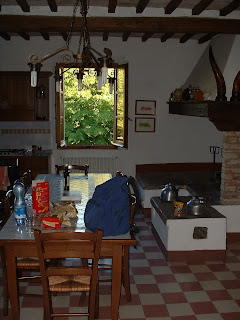 When in Rome, the whole family walked from the Vatican back to our suite near the Piazza Navona. And at a stop along the way, my DH had a conversion experience.
When in Rome, the whole family walked from the Vatican back to our suite near the Piazza Navona. And at a stop along the way, my DH had a conversion experience.No, it wasn’t the religious kind, despite our being moved by the Sistine Chapel. He had a deep and profound transformation that will forever be part of our family lore. My DH had a piscatorial conversion. On that special day in Rome, down a quiet street, under a canopy, DH joined me in my love and adoration of the Anchovy. I am no longer a lonely voice in the wilderness, asking that these little fish sit only on my half of a pizza, or compulsively ordering authentic Caesar Salads wherever they’re offered, or sneaking anchovy paste in our pasta sauce.
Let me set the scene. We are hot, tired, and thirsty. We’ve been walking in the Italian sunshine for over an hour, and it’s doubtful that we’ll find an open establishment at this late afternoon hour. Then we turn into an alleyway and see it. A shining beacon of comfort and delight, our resting place . . . the Antica Taverna. It is open, it is serving refreshment, and it has a lovely table in the shade. Once we have our water and wine before us, I begin to survey the plates of food served to other patrons. “Let’s look at the menu,” I suggest. “I could nibble on something.” And there, among the primi, are powerful words swimming before my eyes. I make out the most important one: Alici. Simple, unadulterated alici. Daydreaming aloud, I wonder how these anchovies would taste with my chilled vino blanco. DH, feeling content as a cat in the sun, says two inspirational words: “Order them.”
They arrive on a bed of warm arugula, with toast and butter on the side. Spread some butter on the bread, add greens, and place the salty fish on top. Mmmm . . . heavenly. Feeling peckish, too, DH reaches for the knife and makes his own anchovy treat.
Time stops. The surrounding light turns aqua. A tinny chorus of anchovy angels bubble out underwater “hallelujahs.” DH has found his way.
With the fervor of a new convert, DH has been making up for lost time. We now order anchovies everywhere, on everything. We work assiduously to recreate our Roman snack at home. He sings the praises of anchovies to anyone who will listen. “You don’t understand,” he says, echoing his wife in years past, “These little fishies are glorious. They deserve our exaltation, not our scorn.”
Last Saturday, we took a hot trek through Durham, admiring the architectural beauties on Watts Street and letting DH reminisce about his hometown. As a boy he dreamed this house would be his one day--rosy color and all:
 It was delicious—buttery, salty, with a yeasty undertone, on perfectly toasted bread. DS had the proscuitto, mozzarella, and tomato sandwich (“It’ll be just like a pizza, we assured him).
It was delicious—buttery, salty, with a yeasty undertone, on perfectly toasted bread. DS had the proscuitto, mozzarella, and tomato sandwich (“It’ll be just like a pizza, we assured him).
It had good flavors, but the ham was a little on the tough side. We also tried two crostini: one with warm goat cheese, local honey, cracked black pepper (stellar!!) and the other with peperonata and pecorino romano (fine, but a little uninspired next to the goat cheese gems)
Panini, crostini, bruschetta, yum. Toast is a “slice” of Italy in Durham, helping us keep the anchovy faith.































